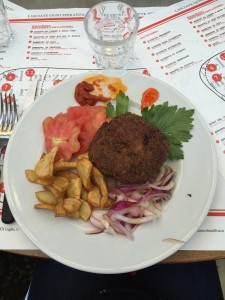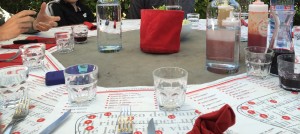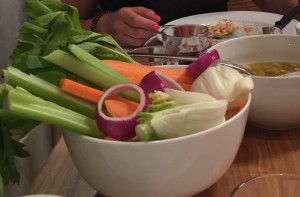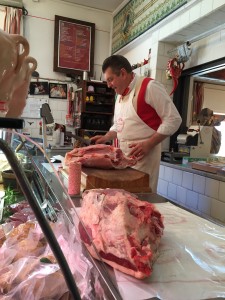Dario is an exceptional butcher who has dedicated his life to raising animals in a humane way. Why does he wait for twelve to fourteen years to use a cow for meat? Why is this a worthy investment? Dario’s philosophy is not derived from the “clean eating” craze that is occurring in the U.S. but it is rooted in a relationship between animals and humans. He acknowledges the need to understand that each time we are consuming meat, we sacrificed that animal for our own needs. Once Dario explained this dynamic and act of consumption, my relationship with food began to change.
After learning about Dario’s methods and overall philosophy and mission, I had an indescribable experience eating the McDario burger. Not only did I solely enjoy the burger, but I valued the entire meal. We sat down and consumed raw vegetables with olive oil and rosemary sea salt as well as some bread. The crisp carrots and celery as well as the warm and bitter flavors from the rosemary sea salt prepared my pallet for the main event.Once I received my medium McDario burger I thought that the plate was beautiful; the colors were balanced with the celery leaves, fresh tomatoes, and red onions. The smell contributed to an overall feeling of emotion that I find difficult to describe. The smell, the colors, the balance that was omnipresent throughout the meal represented the region as well as my own home. I felt the love, comfort, and thoughtfulness that I feel when I am home but I also found that this meal was beautiful and my excitement and energy matched how I feel at an art exhibit.
From my experience I found that I clashed with Elizabeth Telfer’s opinion of food as an art form. Telfer argues that food can only be a minor art because we cannot have an “aesthetic reaction to taste and smell.” I strongly disagree with her because a meal can withdraw my memories, experiences, and feelings with a smell or with the way in which the meal is assembled. Food can articulate how I feel at times when I cannot actually express myself clearly. Food screams louder, infiltrates my senses faster, and communicates more than some pieces of art can regardless of how bright they are, large, or detailed. Telfer may partially agree with my point of view, however she may argue that I am not calculating hunger into this equation. What she ultimately fails to recognize is our visual hunger for stimulation, color, and texture that can be satiated through the painting or visual that she is referencing.
Dario’s philosophy and dishes are exquisite to me and are works of art. They are aesthetically appealing and taste and smell greatly contributes to my emotions toward food. What also adds to the value of Dario’s artwork is the beautiful concept of a human being’s relationship to food and the respect that we must have of nature; our existence relies on the sacrifice of life.
This philosophy increases the value of the McDario burger in a way that is comparable to the stories behind some of the most influential and remarkable paintings.
Additionally, Dario’s philosophy highlights our role as consumers. It is essential that we understand our role in the food industry and the fact that we are an integral part of the food chain. Singer feels that the solution to inhumane treatment to animals is through vegetarianism or eliminating ourselves from the equation, however this is merely hiding from the problem instead of taking a proactive stance as a consumer. We need to have a better connection to our food and understand that each dish is truly one of a kind because we sacrifice a life in order to create it.




